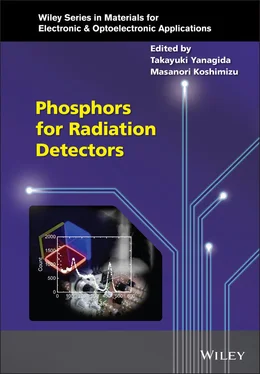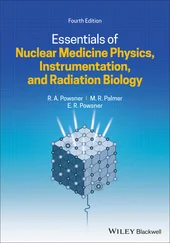Phosphors for Radiation Detectors
Здесь есть возможность читать онлайн «Phosphors for Radiation Detectors» — ознакомительный отрывок электронной книги совершенно бесплатно, а после прочтения отрывка купить полную версию. В некоторых случаях можно слушать аудио, скачать через торрент в формате fb2 и присутствует краткое содержание. Жанр: unrecognised, на английском языке. Описание произведения, (предисловие) а так же отзывы посетителей доступны на портале библиотеки ЛибКат.
- Название:Phosphors for Radiation Detectors
- Автор:
- Жанр:
- Год:неизвестен
- ISBN:нет данных
- Рейтинг книги:3 / 5. Голосов: 1
-
Избранное:Добавить в избранное
- Отзывы:
-
Ваша оценка:
- 60
- 1
- 2
- 3
- 4
- 5
Phosphors for Radiation Detectors: краткое содержание, описание и аннотация
Предлагаем к чтению аннотацию, описание, краткое содержание или предисловие (зависит от того, что написал сам автор книги «Phosphors for Radiation Detectors»). Если вы не нашли необходимую информацию о книге — напишите в комментариях, мы постараемся отыскать её.
Phosphors for Radiation Detectors
Discover a comprehensive overview of luminescence phosphors for radiation detection Phosphors for Radiation Detection,
Phosphors for Radiation Detection
Phosphors for Radiation Detection
Phosphors for Radiation Detectors — читать онлайн ознакомительный отрывок
Ниже представлен текст книги, разбитый по страницам. Система сохранения места последней прочитанной страницы, позволяет с удобством читать онлайн бесплатно книгу «Phosphors for Radiation Detectors», без необходимости каждый раз заново искать на чём Вы остановились. Поставьте закладку, и сможете в любой момент перейти на страницу, на которой закончили чтение.
Интервал:
Закладка:
1.3.2 Emission Mechanism
Figure 1.4summarizes typical emission mechanisms in a scintillator, and the same classification is also possible for dosimeter materials. There are two kinds of luminescence in scintillators, namely intrinsic and extrinsic emissions. The intrinsic luminescence represents free‐exciton luminescence, self‐trapped exciton (STE) luminescence, Auger free luminescence, and self‐activation luminescence. The free exciton luminescence is observed in wide band‐gap semiconductor materials having direct transitions. In this type, common examples are ZnO [16] and GaN [17]. Scintillation due to free exciton is characterized by fast scintillation decay (1–10 ns) with a sharp emission peak in the spectrum. Recently, Ga 2O 3is found to have fast and very intense scintillation upon γ‐ray irradiation [18]. Although Ga 2O 3is still under discussion, whether it is a direct‐ or indirect‐transition type of semiconductor, it shows an attractive scintillation performance.

Figure 1.4 Typical emission mechanisms of scintillation.
STE is observed in wide‐band‐gap insulator materials, such as undoped alkali halides. Common properties of STE are summarized as follows: a broad emission peak in the emission spectrum, a large Stokes shift, a relatively high light yield in scintillation, a relatively fast decay time from several hundred ns to a few μs, and a large temperature dependence of the scintillation light yield. The most common materials are BaF 2[8], SrF 2[19], CaF 2[20], and their mixed compounds.
AFL is observed in some materials which have a larger band‐gap energy than the energy between the core and the valence bands [21]. AFL generally shows a very fast luminescence decay (~1 ns) with a short emission wavelength (VUV‐UV). The common materials are BaF 2[8], BaMgF 4[22], CsF [23], and Cs 2ZnCl 4[24]. Up to now, AFL has been observed in halide materials, and a search for other compounds (oxides and nitrides) is an interesting research topic. Conventionally, it was considered that they have no temperature dependence concerning the scintillation light yield [25], but we recently revealed that AFL materials also show temperature dependence [26]. The disadvantage of AFL scintillators is a relatively low scintillation light yield. The details of AFL are described in Chapter 4.
Self‐activation type scintillators are composed only of the host, and this type can be classified as belonging to the intrinsic luminescence‐type materials. The difference from other intrinsic‐type materials is that the host material contains luminescent ions as a main element. Common scintillators of this type are BGO [7], CeF 3[27], and CeBr 3[28]. Scintillations from BGO are caused by ns 2transitions of Bi 3+, and those of the latter two materials are due to the 5d‐4f transitions of Ce 3+. Although the emission mechanism is not fully understood, recent results of Tl‐based crystals, such as TlMgCl 3and (Tl 1−xA x)MgCl 3(where A = alkali metal), show very high scintillation light yields [29, 30], and their emission will relate to Tl +. In these materials, the emission properties are governed by the luminescent ions of the host, but this class of materials do not suffer from concentration quenching.
Then, the topic moves to materials with extrinsic luminescence. The first one is defect‐based luminescent materials, and the most common defect relating to luminescence is the F‐center, which is characterized by one electron captured at an anion vacancy. Materials containing F‐centers sometimes show scintillation. Common materials with an F‐center are simple oxide materials, such as MgO [31] and Al 2O 3[32]. In addition to F‐centers, there are some other defect‐based luminescence centers, for example, F +‐ and F −‐centers. Although defects are not exactly activators, defect‐based luminescence is sometimes categorized as extrinsic emission.
Luminescence due to the ns 2↔ nsnp transition is one of the common electron transitions involved in many scintillators, such as Tl‐doped NaI [6] and Tl‐doped CsI [33], which are very traditional scintillators. These traditional scintillators were discovered around 1940, and ns 2ions have become a familiar dopant in this field. The spectral feature of the ns 2↔ nsnp transition is characterized by a broad emission band, and the emission wavelength is from near UV to VIS. Because the decay time is from several hundred ns to several μs, it is acceptable for pulse‐height‐based scintillation detectors. In this type of luminescence, in addition to Tl +and Bi 3+, In +[34] and Sn 2+[35] have shown interesting scintillation properties in recent years.
In scintillators, transitional metal ions are sometimes activated to obtain a high luminescent efficiency for integration‐type detectors. The spectrum of 3d‐3d and 4d‐4d (d‐d) transitions has a broad luminescence feature, and the decay time is typically of the ms order. Among the transitional metal elements, Mn 2+[36] and Cr 3+[37] are sometimes selected for scintillation detectors due to a good spectral matching with Si‐PD.
Electron transitions of the 4f‐4f and 5f‐5f levels are called f‐f transitions, and some scintillators use the 4f‐4f transitions of rare‐earth elements because they typically exhibit a high emission intensity with acceptable decay time of several μs to few ms. The most common scintillator based on the 4f‐4f transition is Pr 3+‐doped Gd 2O 2S (GOS) ceramic [38], which is often part of the equipment used in medical X‐ray CTs. The Pr‐doped GOS shows a very high scintillation intensity with a decay time in the medium range (several μs). The luminescence due to the 4f‐4f transitions of Pr 3+appears in yellow‐green, which is well‐matched with the spectral sensitivity of Si‐PD. For practical uses, Ce 3+is co‐doped to suppress the afterglow level. Recently, Eu 3+‐doped (Lu,Gd) 2O 3[39] has attracted much attention for X‐ray CT. The emission intensity is higher than other materials, and the emission wavelength is in red where Si‐PD has a high sensitivity. In addition to these materials, we have investigated doping with other rare‐earth ions in order to develop near‐infrared emitting scintillators. For this purpose, Nd 3+, Ho 3+, Er 3+Tm 3+, and Yb 3+have been selected as the emission center.
Emission due to 5d‐4f transitions of trivalent and divalent rare‐earth ions are very important in recent scintillation detectors because they show intense and fast emissions by the spin‐ and parity‐allowed transitions. The most common emission center is Ce 3+, and examples of commercial scintillators are Ce‐doped Lu 2SiO 5(LSO) [40], (Lu,Y) 2SiO 5(LYSO) [41], Gd 3(Al,Ga) 5O 12(GAGG) [42], Y 3Al 5O 12(YAG) [43], YAlO 3(YAP) [44], LaBr 3[45], and Cs 2LiYCl 6[46]. Except for garnet materials, including GAGG, most scintillators have emission wavelengths of 300–400 nm with 30–60 ns decay times, and these properties are suitable for conventional PMT readouts. In addition to Ce 3+, Pr 3+can also show luminescence due to the 5d‐4f transition in some host materials. The appearance of the 5d‐4f transition depends on the relative positions between the lowest 5d and 1S 0levels. Common Pr‐doped scintillators are Pr‐doped LuAG [47], Lu 2Si 2O 7(LPS) [48], and YAP [49], which show light yields of 10 000–20 000 ph/MeV with a 20 ns decay time. Compared with Ce‐doped scintillators, the emission of Pr‐doped materials appears in the shorter wavelength range, typically at 250–350 nm. Some other trivalent rare‐earth ions show 5d‐4f transitions only in hosts with a wide‐band gap energy, and the emission wavelength is in VUV. A common example is Nd‐doped LaF 3, which has an emission wavelength at 175 nm with a few‐ns decay time [50] due to the 5d‐4f transition of Nd 3+. Divalent Eu also shows a very high scintillation light yield with a typically ~1 μs decay time, which is acceptable for the photon counting type detectors. Typical examples are Eu 2+‐doped SrI 2[51], CaF 2[52], LiI [53], and LiCaAlF 6[54]. Recently, luminescence due to the 5d‐4f transitions of Sm 2+ions was also reported [55], and further investigations are in progress. Sm 2+shows emission in the near‐infrared range, and has attracted much attention for use in Si‐PD type photodetectors. Figure 1.5shows typical scintillation spectra of such scintillators with various emission wavelengths superposed with typical quantum efficiency curves of common photodetectors. It should be noted that the emission wavelength by 5d‐4f transitions strongly depends on the crystal field, which is specific to each host lattice; the presented data are only examples.
Читать дальшеИнтервал:
Закладка:
Похожие книги на «Phosphors for Radiation Detectors»
Представляем Вашему вниманию похожие книги на «Phosphors for Radiation Detectors» списком для выбора. Мы отобрали схожую по названию и смыслу литературу в надежде предоставить читателям больше вариантов отыскать новые, интересные, ещё непрочитанные произведения.
Обсуждение, отзывы о книге «Phosphors for Radiation Detectors» и просто собственные мнения читателей. Оставьте ваши комментарии, напишите, что Вы думаете о произведении, его смысле или главных героях. Укажите что конкретно понравилось, а что нет, и почему Вы так считаете.












